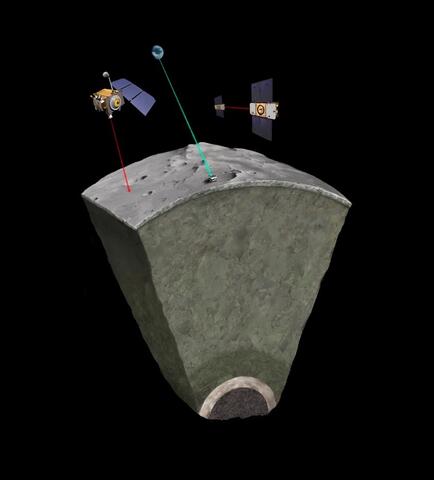The Moon opens its heart for the first time
Fifty years after Apollo 11 paved the way for the first studies of the Moon, a team of scientists from the CNRS, Université Côte d'Azur, Observatoire de la Côte d'Azur, Sorbonne University and Observatoire de Paris-PSL have revealed part of its internal structure that has remained a mystery until now: the Moon has a solid core, just like the Earth. This discovery is also accompanied by the identification of data to explain the presence of iron-rich materials in the lunar crust. This work will be published in Nature on May 3, 2023.
-
Arthur Briaud, CNRS researcher
-
+33 4 83 61 85 69
-
Agnès Fienga, Astronomer, Observatoire de la Côte d’Azur
-
Bastien Florenty, CNRS press service
-
+33 1 44 96 51 26
- By combining various techniques, the internal structure of the Moon has just been revealed.
- These results confirm that the Moon has a solid core, like the Earth.
- They also confirm the "mantle reversal" and explain the presence of iron-rich elements on the Moon's surface.
While the evolution of the Moon is discussed, the nature of its deep structure has just been decided. Fifty years after the first space missions to the Moon, there is no doubt: the Moon has a solid core in the center and a fluid one on the periphery, like the Earth. This hypothesis has just been validated thanks to work carried out by scientists from the CNRS, Université Côte d'Azur, Observatoire de la Côte d'Azur, Sorbonne University and Observatoire de Paris-PSL.
About twenty years after the identification of a fluid outer core, the team1 has revealed a solid core of about 500 km in diameter, about 15% of the size of the Moon. It is composed of a metal whose density is close to that of iron. Techniques, in particular related to the rotation of the Moon had made it possible to clearly identify the fluid external core. However, the solid core had remained undetectable, given its small size. The existence of the latter could be proven2 thanks to the use of data from different space missions and laser-Moon telemetry.
Beyond this major discovery, some elements highlighted by scientists seem to support the hypothesis of material displacement in the mantle, the intermediate layer between the core and the crust of the Moon during its evolution. This is called the lunar mantle overturn and it helps explain the presence of iron-rich elements on the surface of the Moon. How did this phenomenon occur? Material could have risen to the surface and produced volcanic rocks deposited in the lunar crust. Then, the elements too dense compared to the surrounding material in the crust, fell back and returned to the interface between the mantle and the core.
This work provides indispensable knowledge, in particular to inform the history of the solar system and to understand certain events, such as the disappearance of the lunar magnetic field: originally one hundred times more powerful than that of the current Earth, it is now almost non-existent.

1- Working at the Geoazur laboratory (CNRS/Observatoire Côte d'Azur/IRD/Université Côte d'Azur) and at the Institut de mécanique céleste et de calcul des éphémérides (Observatoire de Paris-PSL/CNRS).
2- These results were obtained thanks to funding from the French National Research Agency (ANR-19-CE31-0026), and an ERC Advanced AstroGeo grant (885250).
References:
About the lunar solid inner core and the mantle overturn. Arthur Briaud, Clément Ganino, Agnès Fienga, Anthony Mémin et Nicolas Rambaux. Nature, le 3 mai 2023. DOI :10.1038/s41586-023-05935-7
